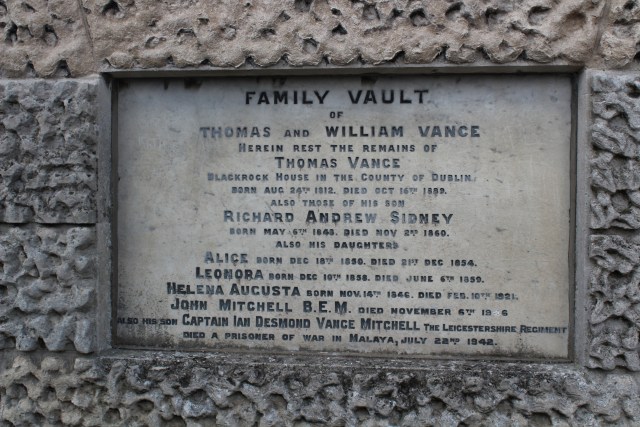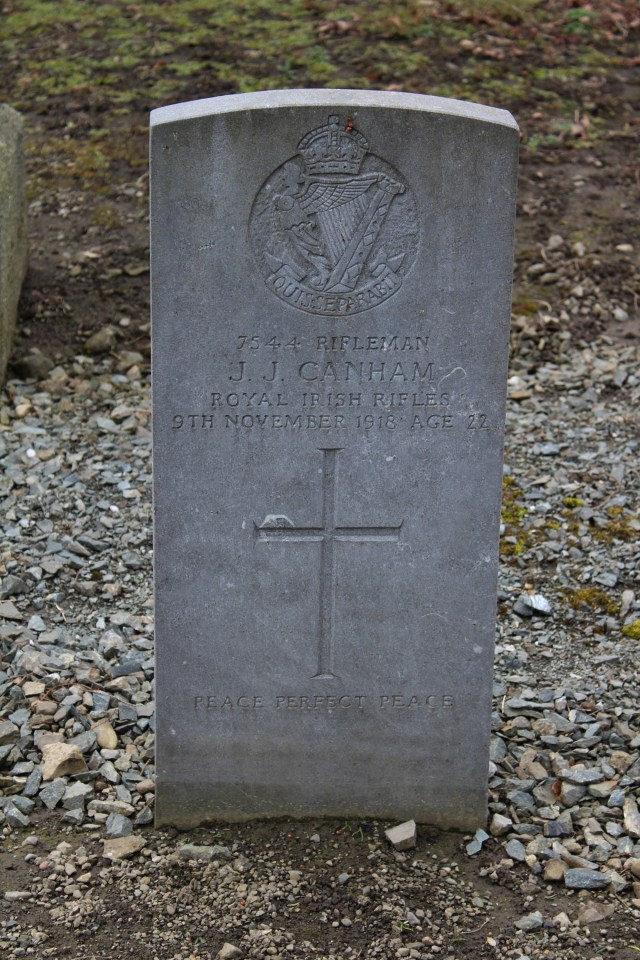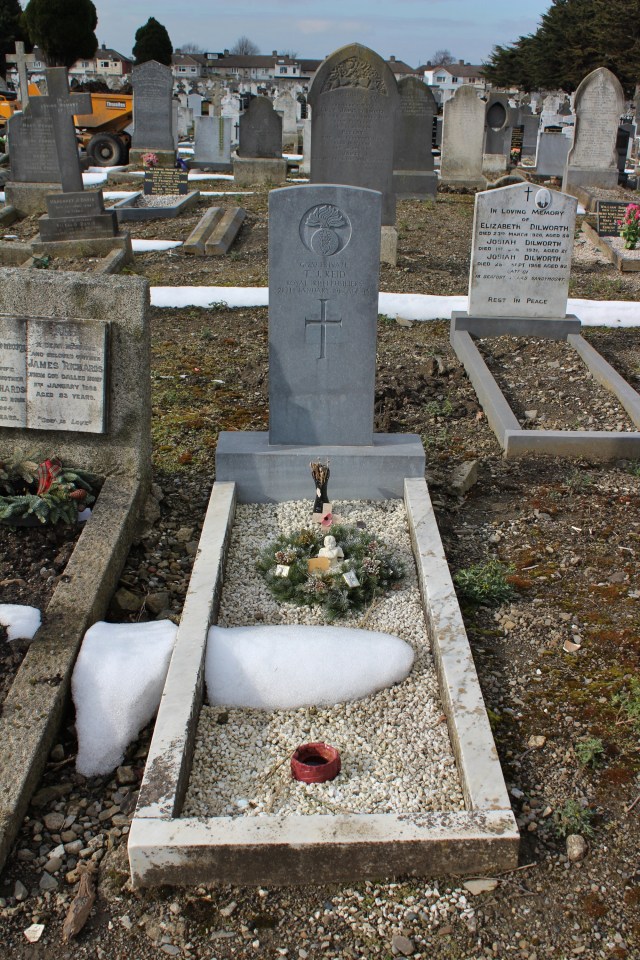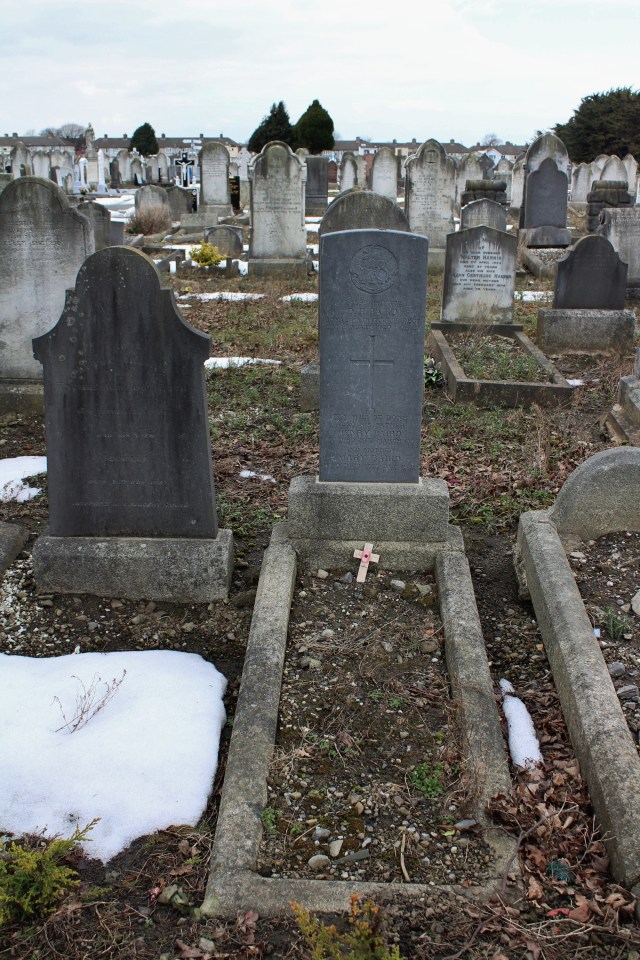Mount Jerome Cemetery covers some fifty acres of land only two miles or so south west of Dublin City centre. There are thirty five Great War and thirty nine Second World War burials here, the only problem facing me as I arrived – apart from, as ever, time – being where exactly to find them.
And so, as with all of these large cemeteries,…
…the first question is always where to start? In particular here, with over 220,000 burials to investigate.
I chose a route to the right,…
…and it always bodes well when you are rewarded by the very first headstone you take a close look at*,…
*not strictly true, but I am an optimist. Sometimes.
…which on this occasion happened to include the name of Second Lieutenant Thomas Wallace Russell, Royal Dublin Fusiliers, killed in action on 13th November 1916 aged 19, and buried at Knightsbridge Cemetery, Beaumont Hamel, on the Somme.
There are some grand tombs and vaults in this section of the cemetery,…
…this one mentioning Captain Ian Desmond Vance Mitchell, Leicestershire Regiment, who died a prisoner of war of the Japanese in Malaya on 22nd July 1942.
Grand indeed. But not what we are looking for.
However, it does seem that the further west we walk,…
…the more open the spaces between the graves become, and the easier it is to manoeuvre between them.
And thus we find ourselves at this small tomb, which marks the very first burials in this vast place, two children who died in 1836.
The route to the left,…
…eventually leads to these graves which are clearly much more recent; there may well be some Second World War burials within, but time doesn’t allow a search of this area on this day.
And as we retrace our steps slightly, two shots (above & below) that show the obvious difficulties encountered when searching cemeteries as big as these,…
…because, although I’ve been doing this for some years now, I still have to work out which areas to look at closely, which areas to skim through, which headstones are more likely than others to be early 20th Century, and so on. I make it sound like a chore. It isn’t. But there is always a ticking clock, always Old Father Time looking over your shoulder, and always the possibility that you might not find what you are looking for (which does happen, occasionally, and did happen, twice, on this particular Dublin trip, as I will relate to you one of these days).
Anyway, having spoken to a few of the cemetery workers as I walked, I ascertained that there is no military plot here; all the headstones are scattered throughout the cemetery, which doesn’t make life any easier, but they did advise me to look for grey, not white, headstones. The route to the right past the two children’s grave proved the correct one,…
…although, of course, the first CWGC headstone I spotted happened to be one of the few white CWGC headstones here,…
…that of Private N. N. Fryday, 75th Bn. Canadian Infantry, who died on 30th April 1916 from wounds received when he was shot in the abdomen during the Easter Rising. The only reason I could think of as to why a Canadian would be in Dublin at the time was that he had been sent to a Dublin hospital to recover from injuries probably incurred at the front. Wrong. Very wrong, actually. Neville Nicholas Fryday was born in County Tipperary, Ireland, and, according to the census, was two years old in 1901. Some time after his twelfth birthday, Neville emigrated to Toronto where a number of his brothers had already settled, and, along with his elder brother William (see inset), in July 1915 he enlisted in the Canadian Expeditionary Force to fight the Hun in Europe, giving his date of birth as 4th September 1893 and his age as 21 years and 10 months.
If you haven’t worked it out, he was actually most likely sixteen, possibly seventeen, no older. After training in Canada, Neville and William arrived in Liverpool on 9th April 1916, and it seems were soon given leave to visit their mother, now living in Dublin. They were still there as the Rising began, and were called on to help the British quell the rebellion, and it was thus that Neville lost his life, still just seventeen years old.
Nearby,…
…next to the unfortunate Charles Hayter, a civilian, one of about 240 in total, who was accidentally shot and killed on 28th April 1916, the Friday of the Easter Rising, aged 77,…
…another soldier who died that week,…
…Rifleman D. Wilson, Royal Irish Rifles, killed on the first day of the Rising, Monday 24th April 1916. The 3rd Bn. Royal Irish Rifles, mainly a training battalion readying soldiers for distribution throughout the regiment, were stationed at Portobello Barracks when the fighting began. A second lieutenant returning to the barracks had been attacked and slightly wounded by rebels occupying Davy’s public house, overlooking Portobello Bridge, and the battalion reacted swiftly, one group of soldiers capturing Davy’s, another securing Dublin Castle after a fight with rebels on the way, and a third group managed to occupy the vitally strategic Dublin Telephone Exchange. With a date of death of 24th April, it would seem likely that Rifleman Wilson was one of the casualties of those early skirmishes.
Thomas Cunningham,…
…who fought with the Royal Dublin Fusiliers in Flanders. One of the men who came home.
As we tour this cemetery, I shall include one or two other unusual headstones or memorials that might interest you,…
…such as this one to the children of the Bethany Home, over 200 of them, all born to unmarried mothers between 1922 & 1949, all of them dead by the age of three and a half, and all buried in unmarked graves somewhere in this cemetery.
At the bottom of this headstone you will find the name of Captain W. H. Monson M.C., 8th Bn. Royal Dublin Fusiliers, who died of wounds at Guillemont on the Somme on 7th September 1916, and is buried in La Neuville British Cemetery, Corbie.
Lieutenant-Commander Gerald R. Cadiz, Royal Navy, lost at sea when the S.S. Henry Stanley was torpedoed by U-103 off the Azores on 7th December 1942.
Major Samuel W. Dunckley, Royal Air Force, who died in May 1933.
Private P. D. Davis, 12th Bn. Australian Infantry, who died on 2nd May 1917 aged 19.
Benjamin Massey, a fireman and water tender on board S.S. Samaye, who died on 29th November 1947 (the Samaye was actually one of the Liberty Ships – look ’em up).
George Thomas Pearson, Royal Artillery, Master Gunner of the Dublin district, died May 1882.
At the base of this headstone,…
…a small stone remembers Charles (Chas on the above stone?) Fred St. Lawrence, who died in February 1919 of illness contracted on active service, but I can find no such name on the CWGC database.
A victim of one of the most famous of all naval tragedies,…
…William H. Winter, aged 28, who was drowned during the sinking of the R.M.S. Lusitania on 7th May 1915.
Two soldiers, a colonel on the left and a major on the right, from a previous century.
Two headstones,…
…both, if you look closely (above & below), bearing the name of Staff Surgeon George Charles Cumberland Ross, killed in action in the North Sea aboard the cruiser H.M.S. Hawke on 14th October 1914, aged 40.
H.M.S. Hawke was hit by a single torpedo from U-9 in the North Sea off Aberdeen, the ship quickly sinking. 524 officers & men were lost, with less than seventy surviving. The men’s names, including that of George Ross, are all inscribed on the Chatham Naval Memorial.
A captain of the Royal Scots Fusiliers who died in 1905.
Second Lieutenant Thomas Maxwell, Royal Dublin Fusiliers, had volunteered for active service on the outbreak of war in August 1914, and had been at the front since December 1915 before he was killed in action at Ginchy on the Somme on 9th September 1916, aged 20. He is buried in Guillemont Road Cemetery on the Somme.
Assistant Surgeon John Rogers, Royal Navy, H.M.S. Mersey, ‘who died of yellow fever on the West Indian station August 29th 1861 aged 22 years’.
Lieutenant Gerard Irvine Crozier of the Leinster Regiment who died, aged 34, on Cyprus on 28th June 1920, and is buried there in Famagusta Military Cemetery.
The CWGC headstone on the far right of this shot…
…is that of Worker K. Irwin, Queen Mary’s Army Auxiliary Corps, who died on 23rd November 1918. I know nothing at all about her, not even her first name, but I wonder if she was a victim of the flu epidemic?
And within hours of publishing this post, we now know that her name was Katie, and she did indeed die of influenza in hospital in Dublin (see Graham’s post-post comment).
When I spotted this headstone I was disappointed, as I got closer, to see that it clearly isn’t a proper CWGC headstone, but I dutifully photographed it, and it’s a good job I did. Reuben Ellis, once a Serjeant in the Army Hospital Corps, but in 1918 a civilian Office Keeper (Messenger), and well into his sixties, was on board the R.M.S. Leinster when it was torpedoed and sunk on 10th October. He died along with over 500 others, and this is indeed an official CWGC headstone, although a most unusual one, and only recently erected, the CWGC website stating, ‘Please note that this casualty was previously commemorated on the Hollybrook Memorial, Southampton; his name will be removed when the appropriate panel is next replaced’.
Rifleman J. J. Canham, Royal Irish Rifles, who died on 9th November 1918 aged 22.
The grave of a sixteen year old King’s Scout who died in November 1918 and who ‘did his duty’.
Two men who died in January 1920,…
…on the left Private A. Burtenshaw, Royal Army Veterinary Corps,…
…and on the right Private M. James, Connaught Rangers.
Private 2nd Class William G. Turner, Royal Naval Air Service, who died of meningitis at Alexandria on 26th December 1918, aged 25, and is buried in Alexandria (Hadra) War Memorial Cemetery in Egypt.
Private T. J. Reid, Royal Irish Fusiliers, who died on 28th January 1916, aged 45.
Private D. Baird, Royal Warwickshire Regiment, who died on 21st January 1920 aged 27. The names of his mother and father have been added to the bottom of the headstone.
Aircraftman 1st Class P. H. Collins, Royal Air Force, who died on 3rd August 1946 aged 55.
Corporal J. Finney, Royal Army Medical Corps, who died on 16th April 1916, aged 50.
Able Seaman Samuel Gault Davey, aged 24, one of ten crew killed when the British steamer S.S. Braefield was torpedoed off the south Wales coast by the German submarine U-57 on a voyage from Cork to Cardiff on 30th March 1917. His name appears on the Tower Hill Memorial.
Captain John Willoughby, aged 62 and Master of the S.S. Lodes, was one of seven crew members lost when the ship hit a mine off the Cork coast on 5th May 1917, and whose name can also be found on the Tower Hill Memorial.
One of four Dublin policemen killed during the Easter Rising, Constable William Frith, aged 38, was wounded in the head in a bedroom at Store Street Police Station on 27th April 1916, dying of his wounds the following day.
Corporal Charles Edward Oates, Royal Inniskilling Fusiliers, who died on 11th November 1925 aged 28. One wonders whether he was one of so many men who died in the years following the war from injuries received during the conflict, but who survived long enough not to qualify for a CWGC headstone.
Ernest Arthur Ross, 28th Canadian (Saskatchewan) Regiment. His parents were Dubliners, he married a Londoner, and he died on 18th April 1916 aged 28 and is now buried in Lijssenthoek Military Cemetery in Belgium.
Beyond the chapel, plenty of snow still on the Dublin Mountains in the far distance.
At the very bottom of this headstone you will see the name Colin followed by AIF. This was Private Colin Campbell Christian, 15th Bn. Australian Infantry, killed at Pozières on the Somme on 17th August 1916. His body was never recovered, and his name can today be found on the Villers-Bretonneux Memorial.
Lieutenant Robert Cecil Morrison of the Cheshire Regiment, formerly a curate, killed in action on 13th November 1916 at Thiepval, aged 27, and buried in Lonsdale Cemetery, Authuille, on the Somme – ‘He was a man and played the game’.
Memorial to the dead of the Home for Aged Governesses and other Unmarried Ladies.
The burial ground of the Female Orphan House, and nearby,…
…the grave of Eliza Shiels, the Matron.
Gunner S. E. Buchanan, Royal Artillery, who died on 5th January 1942 aged 27.
Thomas Patrick O’Byrne, Royal Air Force Volunteer Reserve, killed on active service on 6th March 1943 aged 22.
The back doors!
Captain Cecil Allan Taylor Conyngham, Royal Army Medical Corps, killed in action at the Battle of Tanga in East Africa on 4th November 1914, and buried in Tanga Memorial Cemetery, Tanzania.
The tomb of Thomas Drummond, Scottish army officer, civil engineer and senior public official, according to Wiki, and if you want to know any more about him, you are on your own,…
…bearing his last words; ‘Bury me in Ireland, the land of my adoption. I have loved her well and served her faithfully’.
Lieutenant Geoffrey Montagu Mason Fleming, Royal Army Medical Corps, attd. 2nd Bn.
Bedfordshire Regiment, who was killed in action at Givenchy while attending the wounded, 16th June 1915, aged 25. He is buried in Guards Cemetery, Windy Corner, Cuinchy.
Military families’ graves, the elderly officer at the bottom of the centre headstone, Captain George Thompson, 16th Lancers, dying on the day Great Britain declared war on Germany, 4th August 1914. One wonders whether the news was just too much for him.
Burial place of the Dublin Metropolitan Police, pre-Easter Rising.
The guys in charge of the cemetery had told me they wouldn’t be closing up until 4.30, but as the clock ticked down and I headed towards the cemetery entrance,…
…I was still checking out the inscriptions that I could make out, and it’s a good job I did,…
…because, on one of the last headstones I looked at, I found the name of William Birch, captain of the ill-fated R.M.S. Leinster. William Birch was born in Dublin in 1857 and had spent his life at sea; by the time war came he was a senior captain aboard the Ireland-Wales mail boats, holding the honorary title of Commodore. He was 61 when the Leinster was torpedoed by UB-123 in the Irish Sea and, although he survived the sinking, he was sadly lost just as a rescue ship arrived.
Burial place of the National Institution & Molyneux Asylum for the Blind in Ireland.
Burial Place of the Inmates of the home founded under the will of Elizabeth Mageough, 1878.
The Burial Plot 0f the Old Men’s Asylum.
And finally, back where we started, the grave of Second Lieutenant Thomas Russell, the first burial we visited on arrival, on the right.
The following day would find me in another huge Dublin cemetery, where more casualties from the Great War, the Easter Rising, and the ill-fated R.M.S. Leinster are buried.
And I’ll show you around Dean’s Grange Cemetery in due course.












































































































K. (Katie) Irwin died of Influenza in Adelaide Hospital, Peter Street, Dublin in 1918 – she was 22 years of age.
Cheers Graham. Appreciated. I have added a sentence (and a QMAAC poster) to the relevent piece of this post.